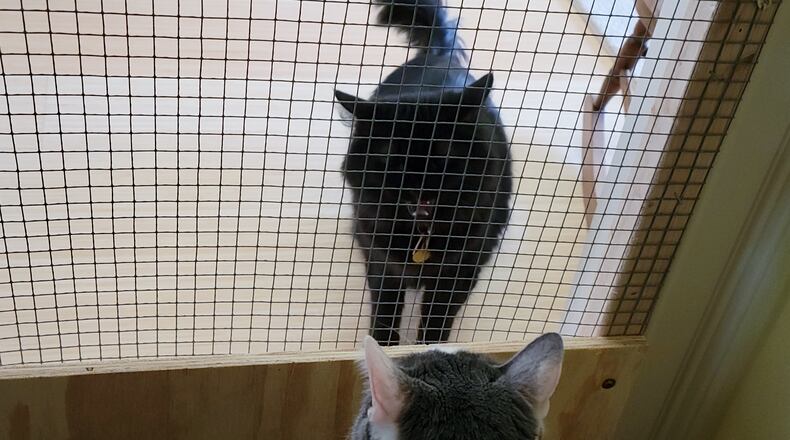My husband, Ed, and I love Wednesday’s playfulness. As for Teddy, our Lab, so long as he’s getting more treats than the cat, he’s OK with her visiting. Pip, our 3-year-old feline and youngest family member, also adores Wednesday and would love nothing more than to play and cuddle with her.
But Wednesday, sadly, wants nothing to do with Pip. She can barely tolerate the little guy as her playful “meeps” quickly turn to hisses whenever he appears.
No great surprise, I guess. As petfinder.com puts it, “Cats are generally territorial by nature and adding a new feline to the mix can cause stress, especially if your current princess is used to being your only cat resident or is dominant by nature.”
That sentence describes our dilemma perfectly. “The Princess,” as Wednesday is called, believes she rules over all who enter her domain. Pip, always ready to play, doesn’t think her “rules” pertain to him.
The human members of the family had hoped the time apart and the fact that Pip was now an adult and calmer would soften Wednesday’s feelings toward him. We hoped wrong.
But we didn’t give up.
As petfinder.com suggests, “Introducing the cats slowly and creating comfort levels for both gives you the best chance of creating a harmonious multi‑cat home.”
We had tried some cat behaviorist suggestions in the past with minimal success. One of those, scent transference, seemed easy enough to help the two get more comfortable with each other.
We simply wiped the cats’ cheek and mouth areas with a clean sock. Then we placed each sock in the opposite cat’s bed, allowing the two to become familiar with each other’s scent.
This strategy, as well as others, produced a level of tolerance. We heard less hissing and occasionally found them relaxing in the cat tree together.
Unfortunately, COVID-19 kept the two apart for more than a year, and when they saw each other a few weeks ago, we learned that absence had not made the heart grow fonder.
We had to start all over again.
Ed had read on petmed.com that using a temporary screen door in a doorway to block the two from getting into each other’s spaces but allowing them to see each other could help them get reacquainted. The site also suggested rewarding each feline with treats for staying in the area.
Ever the mediator, Ed built the screen door from extra material he had in his workshop and then secured it to the frame of the doorway.
We both grabbed a handful of treats and called for Pip and Wednesday. In short order, the two were in the same area but on opposite sides of the screen door.
Pip “meowed” happily, excited to see Wednesday.
Wednesday barely glanced at the adoring cat on the opposite site of the screen door, hissed and turned tail and walked away.
Ever the princess.
Karin Spicer is a member of The Dog Writers Association of America. She lives with her family and two furry pets who inspire her. She can be reached at spicerkarin@gmail.com.
EVEN STEVEN APPROACH
Cat behaviorist Marilyn Krieger, a Certified Cat Behavior Consultant suggests treating both cats the same. Providing separate litter boxes, food and water dishes may limit territorial squabbles.
SOURCE: petmed.com
About the Author

